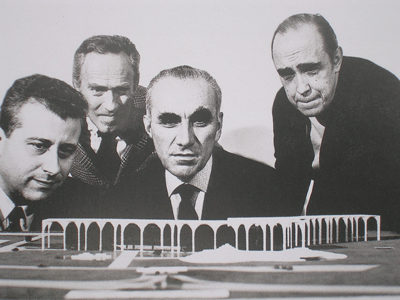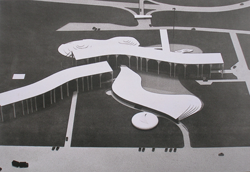You are in: Home page > Magazine Archive > Niemeyer in Milan: the palace Mondadori
Abstract
In the mid-sixties Arnoldo and Giorgio Mondadori decided to erect a new building to house the firm's administrative and editorial offices. Giorgio Mondadori is stucked by a building he saw on a trip to South America: Niemeyer's Itamaraty, which houses the Foreign Ministry in Brasilia (1962-64). Fascinated by it, Mondadori commissioned the Brazilian architect to design the publishing group's new headquarters.
Drawings reveal Niemeter's urge to emancipate himself from the precedent of Itamaraty. Though the pillared elevations in reinforced concrete and parabolic arches with tapering sections were certainly the leitmotiv of both projects, the variations in their arches immediately revealed the distance from the Brazilian model, as well as the definition of the plan of the two buildings. In Brasilia the spacious building with its square plan rested on the ground and was covered by a detached attic, supported by arches. In Segrate the building develops longitudinally, allowing for the installation o a structural system in which the reinforced concrete shell supports the six suspended floors of office space. A simple portal static scheme is repeated crosswise along the positioning of the two main bodies, made structurally independent to allow a fractionated construction.
The longitudinal layout, with its fluid, meandering development, which Niemeyer wanted to use in the Mondadori complex, also appears in his earlier work. The examples range from the Copan Building in São Paulo (1950) to the French Communist Party headquarters in Paris (1965-67). Both these buildings, like the Mondadori headquarters, contain contrasting blocks, each regulated by a distinct kind of compositional and geometrical logic to emphasize their different purpose, as is evident in the National Congress Building in Brasilia (1958), probably one of Niemeyer's best-known work. The dialectical contrast between a high-rise building and a low one, each embodying different kinds of generative geometry, is recurrent in Niemeyer's work. In the constructed building the development of the straight main body replaces the primitive sinuous shape, sublimated by the perceptual illusion of the different width of the arches.
The massive roof from which are suspended the five floors of the office block consists of a double deck of reinforced concrete stabs with a total heigh of about 1.8 meters. The desk is ribbed by a series of cross girders corresponding to the portals and two orthogonal beams, to which are anchored the fifty-six metal ties (28 per beam) of the iron frame. Because of its immense weight (some 24 tons), pouring the concrete for this structure called for a centering of steel tubes 25 meters high, resting on terrain whose elasticity was far from uniform. The suspended steel structure consists of four different blocks. They are divided by two shafts for stairs and elevators, the south and north towers, and by the expansion joint in the middle of the building.
The new Mondadori Building immediately received warm praise in technical periodicals, such as L'Industria delle Costruzioni and Trasparenze, which devoted a cover to it, as well as extensive coverage of the innovative features of the building and the methods of construction. The reaction of the architectural press was more mixed. Even when Niemeyer's arches were featured on the covers of magazines, as in the case of Bauen+Wohnen, the articles inside frequently expressed misgivings about his work. Under the heading “Les paradoxes d'Oscar Niemeyer”, L'Architecure d'Aujourd'hui criticized the contradictions of a modernity inclined to formalism. Casabella was openly unsympathetic to its eye-catching and spectacular qualities.
The Brazilian architect's extraordinary expressive powers were often exerted on the structural members of his buildings, which he modeled in ways that are striking and at times quite irrelevant to their static function. This approach, whose legitimacy Niemeyer explicitly defended on a number of occasions, attracted the arrows of the most stubbornly orthodox defenders of the Modernist gospel. Max Bill, in The Architectural Review. Referring to the Palácio da Alvorada in Brasilia (1957), Piero Luigi Nervi censured the “utterly arbitrary form on the piers”.
Niemeyer deliberately ignored the prescriptive constraints of strict Functionalism. He shared this attitude with Le Corbusier himself, who had worked with the Brazilian architect on the Ministry of Education and Health in Rio de Janeiro (1937-43) and the United Nations building in New York (1949). Le Corbusier's impatience with such prescriptions emerged in his subversive masterpiece of Notre-Dame-du-Haut in Ronchamp (1950-55), whose modeled forms, in part derived from his parallel activity as a painter, reflect the urge to emancipate himself from the hardening conventions of modernism. Niemeyer offended the orthodoxy of militant critics, not only by adopting elements whose geometry and form were extraneous to a strictly rational approach, but by disrupting the whole composition with provocative and exuberant figures. Some critics have tried to relate this poetic to the supposedly gentle lines of the Brazilian landscape or the general influence of Latin America baroque, in an attempt to reintegrate Niemeyer's works with a broader and rather problematic modernist horizon, but this entails legitimating influences that are literary rather than substantial, many of them suggested by the architect himself. On the other hand, it hardly seems speculative to relate the origins of Niemeyer's sculptural exuberance not so much to the Brazilian landscape or the neo-Latin tradition as to the many powerful engineering works built in reinforced concrete in the twentieth century. Again this interest emerges in statements by the architect himself, rather more subtly than in his declarations of love for baroque churches, the sensual female body or the landscape of Rio. Niemeyer declared: “In architecture, the plastic form has been able to evolve thanks to technical innovations and new material that endow it with different and more innovative features,” while in the “old days … limited by a technology that was still archaic, the architect courageously ventured along the paths of dream and fantasy.” And in presenting his recently completed Mondadori complex, the architect justified “the varied rhythm of the arches with that 'symphony of supports' proclaimed by Auguste Perret” so invoking the gifted pioneer of the poetic of reinforced concrete architecture to defend his own approach.
The kind of architectural skill displayed by the Brazilian architect was very different from engineering, so the modeled forms of reinforced concrete that he favored did not save him from something running into formalist excesses that clashed with the rigor of structural logic, as Nervi pointed out in the case of the Alvorada. The Mondadori Building represent the full maturity of Niemeyer's development. Even in the initial sketches he can be seen striving to archive a perfect match between form and structure. It makes a felicitous breakthrough in his work.
The harmonious connection between form and structure logic achieved in the Mondadori Buiding confirmed Niemeyer's gifts of sculptural invention, which had previously led critics to see his work reductively as a skillful but arbitrary formalism. But also it revealed a complexity of thought and reference that made his relegation to an alleged Brazilian modernism truly ungenerous. In reality, it accredited his collocation in a cultural and artistic horizon – Le Corbusier, Nervi, Morandi, Kahn; Brazil, France, Italy – that was many-sided and cosmopolitan.
Roberto Duilio (1971) teaches History of Architecture at the Politecnico di Milano and is in charge of modern and contemporary art and its relationship with art and photography. Among his books: Giovanni Michelucci 1891-1990 (with Claudia Conforti and Marzia Marandola, Milan 2006), Oscar Niemeyer. The palace Mondadori (Milan 2007), Introduction to Bruno Zevi (Rome-Bari 2008), A picture mundane. Photos of Ghitta Carell (Monza 2013).
















